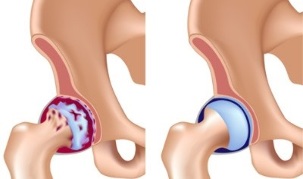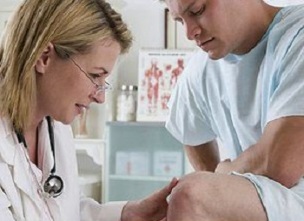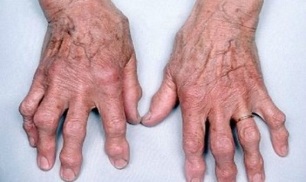These two words are quite similar in listening comprehension, so a lot of people who say the words "arthritis" and "osteoarthritis" don't even suspect that they are entirely different diseases, even though they are linked to joint problems. In fact, both diseases are very serious and it is worth knowing what the difference between arthritis and osteoarthritis is, if only to avoid getting into an awkward position in a conversation, since health is one of the "eternal" topics, whenone person communicates with another.
What is arthritis?
Arthritis is a condition that affects most middle-aged (under 40) people, although there can be exceptions. According to statistics, few people suffer from arthritis, no more than 2% of the total population. But essentially, arthritis is a serious inflammatory process in which joint problems are only the visible part of widespread inflammation.
In arthritis, the main cause of the disease is hidden much more deeply than the swelling of the joints, as well as pain that does not leave the patient even during nighttime rest (sometimes this pain just intensifies). This inflammation can be caused either by an infection or by a disturbed immune system. Joints aren't the only organs affected by inflammation. Often a strong blow falls on such internal organs of a person as the liver, heart and kidneys. If the problem of arthritis is ignored, it will be very dangerous not only for human health but also for his life.
What is osteoarthritis?

Osteoarthritis is by and large an age-related change that a person undergoes, usually closer to the middle of the second half of life. Very often the mechanism of the development of osteoarthritis is provoked by serious injuries in the form of fractures and joint damage in people over 45 years of age.
Medical statistics say that osteoarthritis affects every third over 50 years and every second over 70 years. In general, around 10% of the people on our planet suffer from osteoarthritis. Most often, osteoarthritis affects the knees and hip joints in the elderly. In addition, the joints of the fingers and the ankle can be exposed to osteoarthritis.
The reasons for the development of diseases
It is clear that the causes for each of the diseases are completely different.
In arthritis this can be:
- Injuries of various origins, on a larger scale, recurring injuries in connection with professional activities, can provoke the disease.
- infections like tuberculosis, fungal infection, SARS, flu;
- lack of vitamins and the resulting imbalance in metabolism;
- body overload;
- disorders in the nervous system;
- dysfunction of your own immune system;
- A genetically inherited tendency towards arthritis.
Arthritis is a common companion of people in professions such as seamstress, hairdresser, masseuse, loader and construction worker.
As for osteoarthritis, here are the factors in the development of the disease:
- Overweight, which affects the function of the joints;
- Poor nutrition;
- Prolonged hypothermia;
- suffered various types of injuries before (perhaps even a very long time ago);
- poisoning the body;
- metabolic disorders;
- Previous infectious diseases;
- manifestations of autoimmune diseases;
- Perthes disease, which manifests itself in an altered blood supply to the femoral head;
- diseases of the thyroid gland;
Hereditary tendency to develop osteoarthritis, which is transmitted on a genetic level.
bothersome symptoms in arthritis
Arthritis causes severe joint pain, especially when walking or doing other physical activities. The joint itself swells noticeably and the skin around the joint feels hot to the touch. The skin can also turn red. The patient develops a feeling of weakness, it is very difficult for him to perform movements with the affected arm or leg. It's especially difficult in the morning after a night's sleep. When pressing on the joint, the patient feels severe pain. Joints affected by arthritis can creak a lot when moving. The patient may have an elevated body temperature and the patient himself may have chills at this point. In acute arthritis, all symptoms appear simultaneously and abruptly. In chronic arthritis, symptoms increase slowly and gradually.
Symptoms of osteoarthritis

In osteoarthritis, doctors differentiate between four main symptoms of the disease:
- joint pain.The pain is strong and sharp. It starts the moment the movement begins and subsides with the transition to a state of rest. At night, the person has practically no pain, and having chosen a comfortable position, the patient can sleep peacefully. The pain sensations increase as the disease progresses. The pain is worse even in cold and rainy weather;
- Grinding joints.Due to the limited freedom and softness of the bone rotation, a strong crunch can be heard in the joint. Experts distinguish arthritic crunching by a kind of "dry" sound. The more the disease develops, the stronger the crunch in the joints. A characteristic of the crunch in osteoarthritis is that the crunch is almost always accompanied by pain;
- Limitation of the mobility of the joint itself.With osteoarthritis, the limb is immobilized in many cases. This is due to the fact that bone growth occurs and the joint space narrows, which first leads to a limitation in mobility, and then to complete immobilization of the joint;
- Deformation of the joints.As a rule, this symptom is characteristic of the late stages of osteoarthritis development, when osteophytes grow.
Clinical differences between arthritis and osteoarthritis
It's pretty clear that arthritis and osteoarthritis as diseases have different origins. When arthritis is the result of an immune system malfunction or an infectious disease, osteoarthritis is more likely to refer to diseases that result from the aging process of the body. Accordingly, on this basis, the clinical picture of the manifestations of arthritis and osteoarthritis will also differ.
Arthritis of the fingers

With arthritis of the fingers, the patient has severe pain that does not subside in rest and quiet. The skin around the affected joints will also turn red.
Arthritis can affect a different number of joints, from one (monoarthritis) to several (polyarthritis). The joints are swollen. The reaction to pressing the joint can be a sharp pain.
The crunch in the joint may or may not be present.
Arthrosis of the fingers
It is most common in the elderly, and osteoarthritis is about ten times more common in women than in the stronger sex. The main localization point are the joints between the halves of the fingers.
Every movement of the fingers causes uncomfortable pain in the patient. At rest, however, there is practically no pain. The joints are swollen and there may be reddening of the skin around the affected joint. Osteoarthritis is always accompanied by a "dry" crunch in the joints.
The same picture is observed in arthritis and osteoarthritis of the toe joints.
Treatment with chondreoprotectors
In arthritis and osteoarthritis, the cartilage is destroyed by contact with the rough and rough surface of the bone. As a result, the process of producing synovial fluid is disrupted, the cartilage is deprived of its nourishment, and the lubrication necessary for its normal operation is deprived of the joint.
Chondroprotector prevents these pathological processes. The active ingredient of chondoprotectors is glucosamine and chondroitin sulfate. The dosage forms for the release of these substances are different and can be used by doctors depending on the situation.
Today chondroprotectors are manufactured in the following form:
- injection solutions;
- tablets;
- Creams, ointments and gels.

Chondroprotective treatment should begin before the cartilage has completely collapsed. Unfortunately, if cartilage is destroyed, such treatment is absolutely useless. The next thing to consider when treating with chondroprotectors is the duration of the course of treatment. The fact is that the process of cartilage restoration is quite long, and the minimum course of treatment should be six months. However, practice shows that treatment with chondroprotectors takes an average of one and a half to two years. If the restoration is not complete, the destruction of the cartilage continues. Chondroprotectors, as a rule, have no side effects on the patient's body, the maximum that is observed in practice is mild bowel diseases. The only complication can occur with the treatment of chondroprotectors in people with diabetes mellitus. During treatment, the insulin dose should be calculated correctly, as chondreoprotectors contain glucose. It is also not recommended to use chondreoprotector during pregnancy, as well as to treat children.
There are a number of effective drugs used to treat arthritis and osteoarthritis in the arsenal of doctors dealing with the treatment of arthritis and osteoarthritis problems.
Treatment with chondroprotectors should be started under the supervision of a doctor, otherwise the treatment may be ineffective.
Treatment with folk remedies
For arthritis, traditional medicine recommends several effective recipes:
- Apple cider vinegar.This substance is added to water (1 teaspoon for a glass of water). The resulting solution is drunk before meals;
- Potato compress.Use green tubers for the compress.
Wash, cut into pieces without peeling. Potatoes are heated in water to a temperature of 38 degrees. Then a compress is applied to the sore spot. The potato layer should be 1, 5 - 2 centimeters. It is necessary to bet at night. The course of treatment in this way is seven to ten days.
Ointments for the treatment of arthritis and osteoarthritis
In the initial stages of the development of arthritis, as well as osteoarthritis, the use of topical ointments can be helpful in treating the patient. A specialist will select the appropriate drug based on the results of the examination.



























